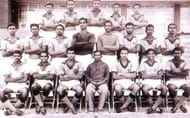The past 3-4 years have seen India host the Indian Super League (ISL) and most recently, the FIFA U-17 World Cup. The inaugural match of the World Cup saw hosts India being beaten 3-0 by the United States and despite this huge loss, pundits praised India's performance, claiming that it was too good for "newcomers" like India.
Since some years, words like "newcomers", "new entrants" have been used frequently by the sports media to describe Indian football, especially since the start of the ISL. Usage of such words might lead one to believe that India is really an unskilled, backward nation in terms of football with absolutely zero history and heritage. Yes, there are people who believe India started playing football only in the 21st century, but, the reality is quite the opposite.
Indian football actually has a rich football heritage that can be compared to that of England, the only difference being that while the latter nurtured it, India chose to ignore. Football in India started in the second half of the 19th century, thanks to the British-Indian Army regiments who started playing it for recreation. It soon became a favorite among the people and the first football clubs of India were established in the 1870s.
But the spread of football on the ground level, i.e, amongst the public, is attributed to a Kolkata teenager - Nagendra Prasad Sarbadhikari. A student of Hare School, Kolkata, Sarbadhikari's love for the game prompted his European teachers to train him and others in the game. He helped start many clubs in Calcutta, making it the de facto "Football Capital" of India and earning himself the title - "The Father of Indian Football".
Not only this, the 19th century saw the introduction of the Durand Cup (the third oldest football competition in the world after the FA Cup and the Scottish Cup) and the IFA Shield (the fourth oldest) -- both of them are still being played in India. As time passed by, more professional clubs came into existence, like Mohammedan Sporting (1891), Mohun Bagan (1899) and many others which still play today. All these clubs won numerous tournaments -- both domestic and international, so many that it wouldn't be possible to mention them all.
And then, the Indian National Football team was formed in the 1930s, under the All India Football Federation. The team took part in its first ever Olympics in 1948, in which it failed to progress beyond the first round. The biggest "what-if?" moment for the Indian Football came during the 1950 FIFA World Cup, Brazil - known to every Indian, the Indian team couldn't attend it because it had no boots. But, the real reason seems to be a cash-strapped Indian Ggovernment's reluctance to spend a huge fortune in sending the team to Brazil.

Despite this, a confident Indian team went ahead to work wonders in other tournaments. Gold in the Asian Games (1951,1962), fourth place in the 1956 Olympics (its best ever performance to date) and many other achievements came in what was called the "Golden Era of Indian Football". The coach responsible for this era was the legendary Syed Abdul Rahim of Hyderabad, after whose death, Indian football began to decline rapidly. Sadly, it plunged into darkness, from which, it is still trying to recover today.
This was the story of Indian football, a story of passion and dominance that had propelled India to reach new heights. A story of how this passion slowly eroded away with time. This story must be told to all those people who think that India is a "newcomer". Because, only after reading this would they realise that India is the sleeping giant that's slowly waking up from its sleep -- to reclaim its lost pride!
